
Tool > Deformation sub-palette
The Tool > Deformation sub-palette provides ways to sculpt 3D objects using unique effects. To see these effects updated in an object on the canvas, it must be in a Transform or Edit mode (selected in the Transform palette). Each Deformation item can be constrained to any or all of the X, Y and Z axes by first pressing the corresponding letter within the item.
If any of these Deformation items are adjusted on a ZBrush default primitive, the tool is first cloned and a copy is added to the Tool palette.
Unify
The Unify button changes the dimensions of the current 3D tool. The object’s height, width, and/or depth are changed to a unit size which fits neatly inside the Object Preview window.
As with most items in the Deformation sub-palette, you can constrain this button’s effect along the X, Y and/or Z axes by first pressing the corresponding letter within this button.
Mirror
The Mirror button flips the current 3D tool so it becomes a mirror-image reflection of itself. As with most items in the Deformation sub-palette, you can constrain this button’s effect along the X, Y and/or Z axes by first pressing the corresponding letter within this button.
Polish
The Polish slider will control the strength of Polish being applied. The icon on the right will determine the polish mode that will be calculated. To change the polish mode click on the circle.
Open Circle will apply a polish that will maintain the overall form of the tool.
Closed Circle will apply a polish that will smooth out the tool without maintaining the volume.
Polish By Features
Polish By Features will evaluate the mesh’s creased edges and polyGroups. ZBrush will polish the whole surface while maintaining PolyGroup borders or creased edges. With the small circle closed, ZBrush will maintain the overall shape and volume of the mesh without shrinking.
With the small circle open, ZBrush will use more aggressive smoothing. You will see some surface volume changed.
Polish By Groups
The Polish By Groups slider will polish the surface based on polygrouping. All polygroups edges will be smoothed.
This powerful feature has a modifier setting in the form of a small circle. With the circle closed, ZBrush will maintain the overall volume of the mesh while polishing based on the surface’s PolyGroup borders. If the circle is open ZBrush will still polish based on PolyGroup border but the overall volume will not be maintained and the mesh will likely contract.
Polish Crisp Edges
The Polish Crisp Edges slider will polish the surface based on creasing. All areas surrounded by creases will be smoothed. This powerful feature has a modifier setting in the form of a small circle. With the circle closed, ZBrush will maintain the overall volume of the mesh while polishing based on Creased Edges. If the circle is open ZBrush will still polish based on Creased Edges but the overall volume will not be maintained.
Relax
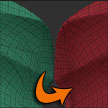
The Relax slider will relax the geometry of a mesh to it original state but still maintain sculptural detail.
Open Circle will apply a polish that will maintain the overall form of the tool.
Closed Circle will apply a polish that will smooth out the tool without maintaining the volume.
Select one or more axes for this action by clicking the small X, Y and Z modifers to turn them on (light) or off (dark).
SmartReSym
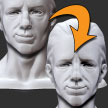
The Smart Realign Symmetry button restores symmetry to the object by examining all points in the mesh from beginning to end and determining which were originally intended to lie in mirror-symmetrical positions.
This button can be used on a mesh which was originally created with mirror symmetry, whether created in ZBrush or imported from another source, even if large-scale distortion has occurred.
You can ‘lock’ one side of an object by masking it before pressing this button; the opposite side then becomes adjusted to mirror the masked side. This is a good way to perform sculpting actions on one side of a mesh (which don’t change the polygon count), as with Projection Master, then reflect them on the opposite side.
Select one or more axes for this action by clicking the small X, Y and Z modifers to turn them on (light) or off (dark).
ReSym
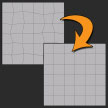
The Realign Symmetry button restores mirror symmetry to the object by adjusting the positions of vertices which lie in near-symmetrical positions. With symmetry restored, the object can be edited using mirror-symmetry modes in the Transform palette.
Depending on the amount of distortion which has occurred, the vertices found in near-symmetrical positions may not necessarily be those originally intended to be symmetrical. For more sophisticated symmetry-realigning, use the Smart Resym button.
Select one or more axes for this action by clicking the small X, Y and Z modifers to turn them on (light) or off (dark).
Offset
The Offset slider moves the object in the direction of the selected axis or axes. After offsetting, each time you place a new instance of this tool on the canvas, it will be displaced by this amount.
The value of this slider is a percentage of this tool’s default unit radius. For example, an Offset amount of 100 along the Y axis moves the tool downward so its new center lies on its top edge.
Select one or more axes for this action by clicking the small X, Y and Z modifers to turn them on (light) or off (dark).
Rotate
The Rotate slider rotates the object around the selected axis or axes. Each time you place a new instance of this tool on the canvas, it will first be rotated by this amount.
Rotating also changes the effective axes for this object. Therefore, all deformations constrained along the X, Y or Z axes act upon the tool in its new orientation.
Select one or more axes for this action by clicking the small X, Y and Z modifers to turn them on (light) or off (dark).
Size
The Size slider changes the shape of this tool by stretching or condensing it along the selected axis or axes.
A value of 100 in this slider expands the object to twice its size; a value of -100 shrinks it to zero.
Select one or more axes for this action by clicking the small X, Y and Z modifers to turn them on (light) or off (dark).
Bend
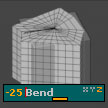
The Bend slider causes the object to be bent in the direction of the selected axis or axes. Polygons on one side of the object, near the centerline, are expanded; polygons on the opposite side are compressed. This type of bending produces a visible seam or crease.
Select one or more axes for this action by clicking the small X, Y and Z modifers to turn them on (light) or off (dark).
SBend
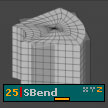
The Smooth Bend slider bends the object around the selected axis or axes, in a smoothly-curved manner. Polygons on one side of the object are expanded, and polygons on the opposite side are compressed.
Select one or more axes for this action by clicking the small X, Y and Z modifers to turn them on (light) or off (dark).
Skew
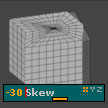
The Skew slider displaces polygons in the direction of the selected axis or axes. Polygons on either side of the centerline are skewed uniformly. This type of skewing produces a visible seam or crease.
Select one or more axes for this action by clicking the small X, Y and Z modifers to turn them on (light) or off (dark).
SSkew
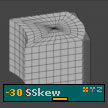
The Smooth Skew slider displaces polygons in the direction of the selected axis or axes. Polygons on either side of the centerline are skewed in a smoothly-curved manner.
Select one or more axes for this action by clicking the small X, Y and Z modifers to turn them on (light) or off (dark).
RFlatten
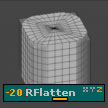
The Radial Flatten slider creates cylindrical faces on the object, around the selected axis or axes. It does this by adjusting all polygons which lie beyond the specified radius so they lie against this cylindrical face. It doesn’t change the number of polygons which compose the object.
Positive or negative values determine whether polygons are flattened inward toward the center of the object, or outward from the center.
Select one or more axes for this action by clicking the small X, Y and Z modifers to turn them on (light) or off (dark).
Flatten
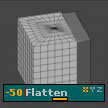
The Flatten slider creates flat faces on the object, along the selected axis or axes. It does this by ajusting all polygons which lie beyond the specified radius so they lie flat against this face. It doesn’t change the number of polygons which compose the object.
Positive or negative values determine which side of the object is affected. For example, when flattening along the X axis, a positive value creates a flat face on the object’s left side; a negative value creats a flat face on the object’s right side.
Select one or more axes for this action by clicking the small X, Y and Z modifers to turn them on (light) or off (dark).
SFlatten
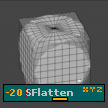
The Spherical Flatten slider creates spherical faces on the object, around the selected axis or axes. It does this by adjusting all polygons which lie beyond the specified radius so they lie against this spherical face. It doesn’t change the number of polygons which compose the object.
Positive or negative values determine whether polygons are flattened inward toward the center of the object, or outward from the center.
Select one or more axes for this action by clicking the small X, Y and Z modifers to turn them on (light) or off (dark).
Twist

The Twist slider produces a twisting effect around the selected axis or axes.
Select one or more axes for this action by clicking the small X, Y and Z modifers to turn them on (light) or off (dark).
Taper
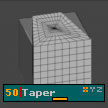
The Taper slider enlarges or shrinks polygons nearer one side of the object. Positive values in this slider cause polygons to be shrunken, and negative values cause them to be enlarged.
Select one or more axes for this action by clicking the small X, Y and Z modifers to turn them on (light) or off (dark).
Squeeze
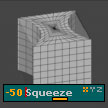
The Squeeze slider produces a squeezing or bulging effect in the direction of the selected axis or axes. Polygons near the centerline of the object are moved toward, or away from, the center of the object in a smoothly-curved manner.
Positive values in this slider cause the object to bulge; negative values cause it to be squeezed.
Select one or more axes for this action by clicking the small X, Y and Z modifers to turn them on (light) or off (dark).
Noise
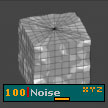
The Noise slider adds random variance to the object’s polygons, moving points in the direction of the selected axis or axes.
Select one or more axes for this action by clicking the small X, Y and Z modifers to turn them on (light) or off (dark).
Smooth
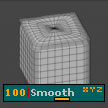
The Smooth slider reduces corners and abrupt changes in the object’s mesh, by comparing each polygon to those surrounding it and making adjustments in its position.
Alternately, the mesh can be roughened by setting this slider to a negative value.
Select one or more axes for this action by clicking the small X, Y and Z modifers to turn them on (light) or off (dark).
Inflat
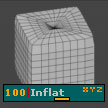
The Inflate slider moves all polygons in the object’s mesh outward, as if filling the mesh with air. The reverse effect can be produced by setting this slider to a negative value.
Select one or more axes for this action by clicking the small X, Y and Z modifers to turn them on (light) or off (dark).
InflatBalloon
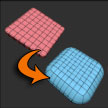
The Inflat Balloon slider will inflate the mesh polygons along the XYZ axis to state that will add volume to the mesh.
Select one or more axes for this action by clicking the small X, Y and Z modifers to turn them on (light) or off (dark).
Spherize
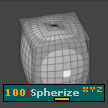
The Spherize slider deforms the object into a spherical shape, in the direction of the selected axis or axes. The value of this slider determines the amount of distortion; negative values cause the object to be distorted away from a spherical shape.
Select one or more axes for this action by clicking the small X, Y and Z modifers to turn them on (light) or off (dark).
Gravity
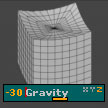
The Gravity slider skews the object in the direction of the selected axis or axes. The effect is similar to that of the Smooth Skew slider, producing a more spherical curve.
Select one or more axes for this action by clicking the small X, Y and Z modifers to turn them on (light) or off (dark).
Perspective
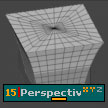
The Perspective slider tapers the object in a manner that resembles perspective foreshortening, along the selected axis or axes.
Select one or more axes for this action by clicking the small X, Y and Z modifers to turn them on (light) or off (dark).
Repeat To Active
The Repeat To Active button will repeat the last Deformation action used, applying it only to the selected subtool.
Repeat To Other
The Repeat To Other button will repeat the last Deformation action used, applying it to the visible subtools except for the selected subtool. Subtools with their eye icons turned off, so that they are not visible, won’t be affected.
Mask
If the Mask option is turned on, then Repeat To Active or Repeat To Other will take account of any masking applied to each subtool. If the Mask option is turned off, then masking is ignored.